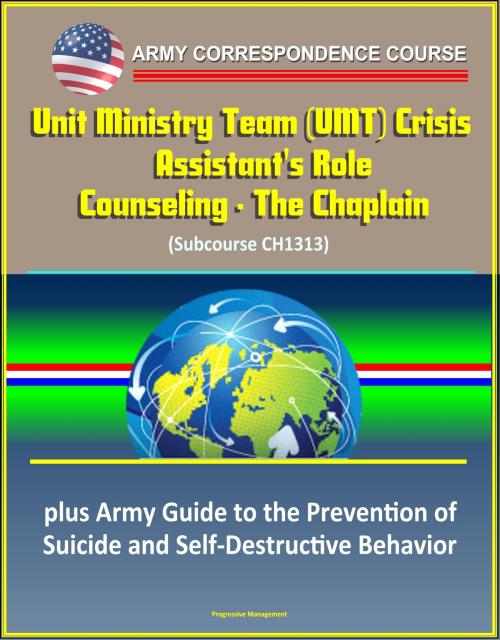Army Correspondence Course: Unit Ministry Team (UMT) Crisis Counseling - The Chaplain Assistant's Role (Subcourse CH1313), plus Army Guide to the Prevention of Suicide and Self-Destructive Behavior
Nonfiction, Religion & Spirituality, Inspiration & Meditation, Counseling, Health & Well Being, Medical, Ailments & Diseases, Mental Health| Author: | Progressive Management | ISBN: | 9781370889990 |
| Publisher: | Progressive Management | Publication: | March 25, 2017 |
| Imprint: | Smashwords Edition | Language: | English |
| Author: | Progressive Management |
| ISBN: | 9781370889990 |
| Publisher: | Progressive Management |
| Publication: | March 25, 2017 |
| Imprint: | Smashwords Edition |
| Language: | English |
Professionally converted for accurate flowing-text e-book format reproduction, this ebook reproduces two Army documents: Unit Ministry Team (UMT) Crisis Counseling: The Chaplain Assistant's Role, and Guide to the Prevention of Suicide and Self-Destructive Behavior.
Lesson 1, Understanding the Distressed Individual * Lesson 2, Drug, Alcohol Abuse, and Suicide * Lesson 3, Referrals * Lesson 4, Helping Distressed Soldiers During Combat * Crisis is a state of disorganization in which people face frustration of important life goals or profound disruption of their cycles and methods of coping with stress. Counseling of any kind is an intensely intimate and personal activity, crisis counseling even more so. Counseling requires a sense of caring, stability, and perceptivity. Moreover, counseling requires recognition of the worth of others from all spheres of life.
Successful counseling also requires a broad educational background and, indeed, a broad outlook on life. It requires basic psychological knowledge and understanding of the employment, social, and domestic environments in which the counseling is done. For the purposes of helping distressed soldiers or their distressed family members, awareness of the unique emotional and psychological dynamics of military life is also essential. Familiarity with community helping agencies is just as essential to the paraprofessional who helps those in crisis as it is to the seasoned professional counselor. In this subcourse you will be required to become familiar with Maslow's hierarchy of needs, with nonwelfare and welfare referral agencies -- civilian and military. As an exercise, you will be asked to read and respond to a case study which deals with the complexities of trying to help a distressed individual. You will also be introduced to ten considerations for first contact response to these individuals.
Suicide among young adults is a serious and growing problem. In the past 25 years, there has been a 300 percent increase in the adolescent suicide rate. More than 6,500 young Americans kill themselves each year. Taking all age groups into account, nearly 30,000 Americans kill themselves each year. Taking all age groups into account, nearly 30,000 Americans die by their own hand each year. There are over 1000 suicide attempts in the United States daily or one every minute of every day. Nationally, suicide is the tenth leading cause of death. In persons 14 to 25 years of age, it is the third leading cause of death and among college students, it is second.
There is no simple answer as to why people choose to kill themselves. Usually, the emotional upset is so great that the person "just wants to stop the pain." The suicidal person feels a tremendous sense of loneliness and isolation. They feel helpless, hopeless, and worthless. Often they believe that it does not matter if they live or die and that no one would miss them. Suicidal people feel that they cannot cope with their problems and that suicide is the only possible way to escape unbearable pain.
Professionally converted for accurate flowing-text e-book format reproduction, this ebook reproduces two Army documents: Unit Ministry Team (UMT) Crisis Counseling: The Chaplain Assistant's Role, and Guide to the Prevention of Suicide and Self-Destructive Behavior.
Lesson 1, Understanding the Distressed Individual * Lesson 2, Drug, Alcohol Abuse, and Suicide * Lesson 3, Referrals * Lesson 4, Helping Distressed Soldiers During Combat * Crisis is a state of disorganization in which people face frustration of important life goals or profound disruption of their cycles and methods of coping with stress. Counseling of any kind is an intensely intimate and personal activity, crisis counseling even more so. Counseling requires a sense of caring, stability, and perceptivity. Moreover, counseling requires recognition of the worth of others from all spheres of life.
Successful counseling also requires a broad educational background and, indeed, a broad outlook on life. It requires basic psychological knowledge and understanding of the employment, social, and domestic environments in which the counseling is done. For the purposes of helping distressed soldiers or their distressed family members, awareness of the unique emotional and psychological dynamics of military life is also essential. Familiarity with community helping agencies is just as essential to the paraprofessional who helps those in crisis as it is to the seasoned professional counselor. In this subcourse you will be required to become familiar with Maslow's hierarchy of needs, with nonwelfare and welfare referral agencies -- civilian and military. As an exercise, you will be asked to read and respond to a case study which deals with the complexities of trying to help a distressed individual. You will also be introduced to ten considerations for first contact response to these individuals.
Suicide among young adults is a serious and growing problem. In the past 25 years, there has been a 300 percent increase in the adolescent suicide rate. More than 6,500 young Americans kill themselves each year. Taking all age groups into account, nearly 30,000 Americans kill themselves each year. Taking all age groups into account, nearly 30,000 Americans die by their own hand each year. There are over 1000 suicide attempts in the United States daily or one every minute of every day. Nationally, suicide is the tenth leading cause of death. In persons 14 to 25 years of age, it is the third leading cause of death and among college students, it is second.
There is no simple answer as to why people choose to kill themselves. Usually, the emotional upset is so great that the person "just wants to stop the pain." The suicidal person feels a tremendous sense of loneliness and isolation. They feel helpless, hopeless, and worthless. Often they believe that it does not matter if they live or die and that no one would miss them. Suicidal people feel that they cannot cope with their problems and that suicide is the only possible way to escape unbearable pain.















